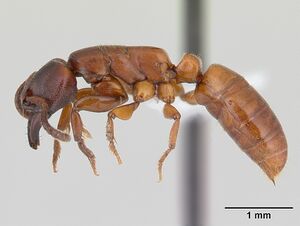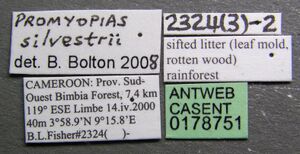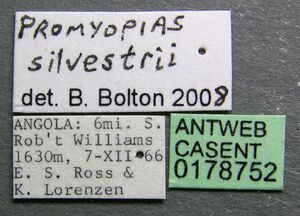Promyopias silvestrii
| Promyopias silvestrii | |
|---|---|

| |
| Scientific classification | |
| Kingdom: | Animalia |
| Phylum: | Arthropoda |
| Class: | Insecta |
| Order: | Hymenoptera |
| Family: | Formicidae |
| Subfamily: | Ponerinae |
| Tribe: | Ponerini |
| Genus: | Promyopias |
| Species: | P. silvestrii |
| Binomial name | |
| Promyopias silvestrii (Santschi, 1914) | |
| Synonyms | |
| |
The only known species in the genus, Promyopias silvestrii is an uncommon but widely distributed species. Its diet, presumably termites but not actually demonstrated, may be more restricted or specialised than in Centromyrmex.
Identification
The morphology of the mandible is unique and readily separates silvestrii from other Ponerinae.
Schmidt and Shattuck (2014) - Workers of Promyopias can be identified by the following unique combination of characters: mandibles narrow and curved, anterior margin of clypeus with a blunt medial projection, eyes absent, metapleural gland orifice shielded laterally by a cuticular flap, traction setae present on mesotibiae and meso-/metabasitarsi, and petiole articulating near the midheight of the first gastral segment. The flap lateral to the metapleural gland orifice is autapomorphic. Promyopias workers may be confused with those of Centromyrmex, Buniapone, or Feroponera, as all four genera share traction setae on the legs, a relatively high helcium, and absent or tiny (in Buniapone) eyes. None of these other genera have similarly narrow and curved mandibles, however, and only Buniapone has a medial clypeal projection. Promyopias may also be confused with Myopias, but Myopias lacks traction setae on the legs, usually has eyes, and has a low helcium (among many other differences).
Distribution
Latitudinal Distribution Pattern
Latitudinal Range: 10.64° to -13.418118°.
| North Temperate |
North Subtropical |
Tropical | South Subtropical |
South Temperate |
- Source: AntMaps
Distribution based on Regional Taxon Lists
Afrotropical Region: Angola, Cameroun, Guinea (type locality), Ivory Coast, Malawi, Mozambique.
Distribution based on AntMaps
Distribution based on AntWeb specimens
Check data from AntWeb
Countries Occupied
| Number of countries occupied by this species based on AntWiki Regional Taxon Lists. In general, fewer countries occupied indicates a narrower range, while more countries indicates a more widespread species. |

|
Estimated Abundance
| Relative abundance based on number of AntMaps records per species (this species within the purple bar). Fewer records (to the left) indicates a less abundant/encountered species while more records (to the right) indicates more abundant/encountered species. |

|
Biology
Schmidt and Shattuck (2014) - Nothing is known about the habits of Promyopias, though based on its morphological characteristics it is undoubtedly hypogeic. Bolton & Fisher (2008c) suggest that it most likely feeds on termites, though this has never been observed. Their hypothesis is apparently based on a presumed close relationship with Centromyrmex, which is a termite specialist. However, the mandibular and clypeal structure of Promyopias is much more similar to that of Myopias, Plectroctena, Leptogenys, and Psalidomyrmex, which are to large degrees specialist predators of millipedes (Myopias, Plectroctena), isopods ( Leptogenys), or earthworms (Psalidomyrmex). Long curved mandibles and medial clypeal projections are apparently favored for the capture of round prey (Déjean et al., 2001), and we hypothesize that Promyopias likewise feeds on some kind of hard round prey, most likely millipedes. On the other hand, both Plectroctena and Leptogenys include species known to feed on termites, so termite predation by Promyopias is not improbable.
Castes
Males have not been collected.
Worker
   
| |
| . | Owned by Museum of Comparative Zoology. |
Images from AntWeb
   
| |
| Worker. Specimen code casent0178751. Photographer April Nobile, uploaded by California Academy of Sciences. | Owned by CAS, San Francisco, CA, USA. |
Queen
Images from AntWeb
   
| |
| Queen (alate/dealate). Specimen code casent0178752. Photographer April Nobile, uploaded by California Academy of Sciences. | Owned by CAS, San Francisco, CA, USA. |
Nomenclature
The following information is derived from Barry Bolton's Online Catalogue of the Ants of the World.
- silvestrii. Myopias (Promyopias) silvestrii Santschi, 1914d: 324, fig. 10 (w.) GUINEA. Combination in Promyopias: Emery, 1915g: 26; in Pseudoponera (Promyopias): Wheeler, W.M. 1922a: 779; in Centromyrmex: Bolton, 1995b: 140. Revived combination in Promyopias: Bolton & Fisher, 2008c: 31. Senior synonym of asili: Brown, 1963: 10.
- asili. Promyopias asili Crawley, 1916a: 30, fig. (q.) MALAWI. Combination in Pseudoponera (Promyopias): Wheeler, W.M. 1922a: 779. Junior synonym of silvestrii: Brown, 1963: 10.
Unless otherwise noted the text for the remainder of this section is reported from the publication that includes the original description.
Description
Worker
Bolton and Fisher (2008) - TL 6.0-6.3, HL 1.05-1.16, HW 1.00-1.12, CI 95-99, ML 0.62-0.68, MI 55-61, SL 0.62-0.64, SI 57-62, PW 0.74-0.86, WL 1.78-1.90 (5 measured).
With characters of the genus and the following. Dorsum of head densely punctulate-costulate, the sculpture stops near the posterior margin so that the occipital surface is mostly smooth and shining. Ventral surface of head longitudinally striolate and with scattered small punctures. Head capsule deep, in profile the maximum depth about 0.75 × HL. Scapes and cephalic dorsum with dense long pubescence that may be elevated, but without long setae such as are present on the clypeus and inner mandibular margins. Pronotum bluntly and obtusely marginate anteriorly and laterally. Metanotal groove vestigial to distinct across the dorsum, not impressed in profile. Pronotal dorsum broadly and densely punctate except for the median strip, which is smooth. Punctate sculpture on mesonotum weaker and more widely spaced than on pronotum; on propodeal dorsum the punctures weaker still, very sparse and almost effaced posteriorly. Sides of mesosoma finely striolate everywhere, or at most with posterior portion of mesopleuron smooth. PW about 1.85 × the maximum width of the propodeal dorsum. Gastral tergites with scattered small punctures. Dorsal surfaces of body with conspicuous pubescence or very short standing hairs everywhere. Occasionally one or two longer setae may occur on the petiole and gastral tergites 1–3, but long conspicuous setae are mostly confined to the apical gastral segment and the gastral sternites.
Queen
Bolton and Fisher (2008) - TL 7.6, HL 1.14, HW 1.17, CI 103, OI 21, ML 0.72, MI 63, SL 0.68, SI 58, PW 0.97, WL 2.32. All main morphological characters of the worker are duplicated in the queen caste; see under diagnosis of the genus.
Type Material
Bolton and Fisher (2008) - Syntype workers, GUINEA: Mamou, 24.viii.1913 (F. Silvestri) (Naturhistorisches Museum, Basel) [examined]. Holotype queen, MALAWI: Mlanje, 15.xi.1913 (S.A. Neave) (The Natural History Museum) [examined].
References
- Esteves, F.A., Fisher, B.L. 2021. Corrieopone nouragues gen. nov., sp. nov., a new Ponerinae from French Guiana (Hymenoptera, Formicidae). ZooKeys 1074, 83–173 (doi:10.3897/zookeys.1074.75551).
- Gomez, K., Hawkes, P.G., Fisher, B.L. 2023. Ant endemicity in the highlands and escarpments of Angola and Namibia (Hymenoptera, Formicidae). Monograph on Endemism in the Highlands and Escarpments of Angola and Namibia. Namibian Journal of Environment 8, 197-203.
- Bolton, B. and B. L. Fisher. 2008c. Afrotropical ants of the ponerine genera Centromyrmex Mayr, Promyopias Santschi gen. rev. and Feroponera gen. n., with a revised key to genera of African Ponerinae (Hymenoptera: Formicidae). Zootaxa 1929: 1-37. PDF
- Santschi, F. 1914d. Formicides de l'Afrique occidentale et australe du voyage de Mr. le Professeur F. Silvestri. Boll. Lab. Zool. Gen. Agrar. R. Sc. Super. Agric. 8: 309-385 (page 323, Promyopias as subgenus of Myopias)
- Schmidt, C.A. & Shattuck, S.O. 2014. The higher classification of the ant subfamily Ponerinae (Hymenoptera: Formicidae), with a review of ponerine ecology and behavior. Zootaxa 3817, 1–242 (doi:10.11646/zootaxa.3817.1.1).
References based on Global Ant Biodiversity Informatics
- Bolton B., and B. L. Fisher. 2008. Afrotropical ants of the ponerine genera Centromyrmex Mayr, Promyopias Santschi gen. rev. and Feroponera gen. n., with a revised key to genera of African Ponerinae (Hymenoptera: Formicidae). Zootaxa 1929: 1-37.
- Bolton, B., and B. L. Fisher. "Afrotropical ants of the ponerine genera Centromyrmex Mayr, Promyopias Santschi gen. rev. and Feroponera gen. n., with a revised key to genera of African Ponerinae (Hymenoptera: Formicidae)." Zootaxa 1929 (2008): 1-37. Abstract
- Brown W. L. Jr. 1963. Characters and synonymies among the genera of ants. Part III. Some members of the tribe Ponerini (Ponerinae, Formicidae). Breviora 190: 1-10.
- Crawley W. C. 1916. A new species of ponerine ant captured by an Asilus. Entomologist 49: 30-31.
- Levieux J. 1972. Etude du peuplement en fourmis terricoles d'une savane preforestiere de Cote d'Ivoire. Revue d'Ecologie et de Biologie du Sol 10(3): 381-428.
- Lévieux J. 1972. Les fourmis de la savane de Lamto (Côte d'Ivoire): éléments de taxonomie. Bulletin de l'Institut Fondamental d'Afrique Noire. Série A. Sciences Naturelles 34: 611-654.
- Santschi F. 1914. Formicides de l'Afrique occidentale et australe du voyage de Mr. le Professeur F. Silvestri. Bollettino del Laboratorio di Zoologia Generale e Agraria della Reale Scuola Superiore d'Agricoltura. Portici 8: 309-385.

